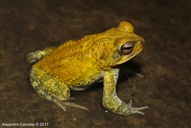|
Incilius marmoreus (Wiegmann, 1833)
| family: Bufonidae genus: Incilius |
 © 2017 Rafael Alejandro Calzada-Arciniega (1 of 10) |
|
|
Country distribution from AmphibiaWeb's database: Mexico
|
|
|
AMPHIBIAWEB
|
|||||||||||||||||||||||
|
(Translations may not be accurate.) |
Country distribution from AmphibiaWeb's database: Mexico
|
||||||||||||||||||||||